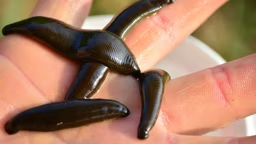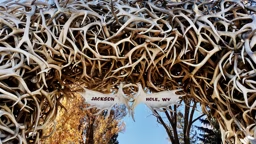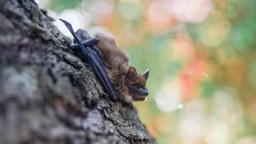The World of the River Otter
Otters are wonderfully equipped to find fast-moving prey in the water column and slow-moving prey amid the mud, rocks and timbers of lake and river bottoms. They are able to navigate from open water patch to open water patch beneath long stretches of ice in northern climates, and they have a very good sense of where prey abounds from corner to corner in their immense territories.
An elaborate sensory package makes otters wonderfully successful in their amphibious lifestyle. Small ears keep the body streamlined and suffice to detect the vocal communication of other otters, as well as approaching threats. Their eyes are well-adapted to two worlds, working well on land and water in detection of prey and threats alike. Underwater, large whiskers, or vibrissae, help communicate volumes of three-dimensional information for this predator that uses its mouth to capture its prey. While an otter can squeeze its nostrils shut underwater, its nose is very useful on land. An otter’s sense of smell is strong and is used to identify territorial markings of other otters.
Where senses may lack, curiosity compensates, and river otters are adept at spy hopping, a synchronized swimming maneuver that allows them to rise up high in the water and look out over their immediate surroundings. This tall, bobbing behavior is famously attributed to river otters and is often accompanied by the otters’ curious scolding calls. Just as nervous dogs bark at what they don’t understand, otters seem to greet the unknown with a hushed, nasal and rasping bark that is repeated over and over again. Once danger is detected and risk has been calculated, otters have a knack for disappearing into the water for long periods of time.
Because river otters are large carnivores, only a few animals will make an effort to eat one. The life of the river otter surely involves some peril, and a life of diving underwater and surfacing again some time later does have its share of blind risks. Bald eagles often prove to be formidable predators. I have witnessed young bald eagles in their attempts at taking otters, though I have never seen a successful hunt. I imagine that an eagle with its talons in an otter would soon realize it had taken the proverbial “tornado by the tail.”
One day in early April, an eagle decided to explore a pair of otters as a potential meal. Gliding in for the attack, it was within a body length of the otters, swooping in from the blind side. Just as its talons stretched forward, both mammals abruptly splashed and disappeared under the water. The eagle soared up into a large oak, and the otters surfaced together, looking around for danger. Within seconds, they began to utter their snorting, rasping alarm barks. The eagle didn’t try again.
Otters are den animals, and dens are important for raising young. For their homes, otters choose a place close to water that offers a stealthy entrance or exit and a dry, warm place to bed down. Along the Mississippi River, I have found otter dens beneath tangled tree root mats, dug into muddy backwater banks. Logs are sometimes used, and one family group of otters in a local state park routinely holed up in a cement culvert at the edge of a small lake.
Otters are wonderfully equipped to find fast-moving prey in the water column and slow-moving prey amid the mud, rocks and timbers of lake and river bottoms. They are able to navigate from open water patch to open water patch beneath long stretches of ice in northern climates, and they have a very good sense of where prey abounds from corner to corner in their immense territories.
An elaborate sensory package makes otters wonderfully successful in their amphibious lifestyle. Small ears keep the body streamlined and suffice to detect the vocal communication of other otters, as well as approaching threats. Their eyes are well-adapted to two worlds, working well on land and water in detection of prey and threats alike. Underwater, large whiskers, or vibrissae, help communicate volumes of three-dimensional information for this predator that uses its mouth to capture its prey. While an otter can squeeze its nostrils shut underwater, its nose is very useful on land. An otter’s sense of smell is strong and is used to identify territorial markings of other otters.
Where senses may lack, curiosity compensates, and river otters are adept at spy hopping, a synchronized swimming maneuver that allows them to rise up high in the water and look out over their immediate surroundings. This tall, bobbing behavior is famously attributed to river otters and is often accompanied by the otters’ curious scolding calls. Just as nervous dogs bark at what they don’t understand, otters seem to greet the unknown with a hushed, nasal and rasping bark that is repeated over and over again. Once danger is detected and risk has been calculated, otters have a knack for disappearing into the water for long periods of time.
Because river otters are large carnivores, only a few animals will make an effort to eat one. The life of the river otter surely involves some peril, and a life of diving underwater and surfacing again some time later does have its share of blind risks. Bald eagles often prove to be formidable predators. I have witnessed young bald eagles in their attempts at taking otters, though I have never seen a successful hunt. I imagine that an eagle with its talons in an otter would soon realize it had taken the proverbial “tornado by the tail.”
One day in early April, an eagle decided to explore a pair of otters as a potential meal. Gliding in for the attack, it was within a body length of the otters, swooping in from the blind side. Just as its talons stretched forward, both mammals abruptly splashed and disappeared under the water. The eagle soared up into a large oak, and the otters surfaced together, looking around for danger. Within seconds, they began to utter their snorting, rasping alarm barks. The eagle didn’t try again.
Otters are den animals, and dens are important for raising young. For their homes, otters choose a place close to water that offers a stealthy entrance or exit and a dry, warm place to bed down. Along the Mississippi River, I have found otter dens beneath tangled tree root mats, dug into muddy backwater banks. Logs are sometimes used, and one family group of otters in a local state park routinely holed up in a cement culvert at the edge of a small lake.
Social, Playful … Practical
Otters are high-energy animals with a demanding metabolism. The home range of an otter can be absolutely immense, depending upon how productive the fishing is in a particular body of water. Wherever river otters are found, they tell a tale of clean water and healthy habitats. Indeed, otters suffer when habitats are degraded, when wetland diversity declines, or when waters are polluted. When the fishing is good, otters will spend hours working on a feast, pulling prey animals from the depths to the surface with surprising frequency.
Endearing, to say the least, otter behavior borders on playful and cuddly. When trying to understand the lives of otters, it is helpful to remember that play is a form of learning, and, in a survival sense, a more entertaining version of work. When otters explore a downhill belly slide, it is an exercise in energy management, a growing life-long lesson for an animal with a greedy metabolism. When otters play “catch and release” with their food, it is an exercise in building the skills needed in hunting quick and slimy prey. Friendly competition builds maneuvering skills and social bonds. Good teachers, otters remind us that our own work should be filled with play.
There is something about otters that appeals to the human spirit. Otters are in touch with each other, sometimes running shoulder-to-shoulder or nose-to-tail. I have seen otters rest on one another, nuzzle each other affectionately, and create gestures and expressions for one another that were subtle, meaningful, and impossible to capture in words.
In my lifetime, river otters have returned from the brink, have responded well to reintroduction efforts, and now occupy healthy waterways across the North American continent. As we enjoy them and find so much in common with our river otters, they should serve to remind us of our own connection to the land and water. As much as they are in touch with each other, we can be in touch with them in good stewardship.
Brian M. Collins is finally starting to figure out how to find, watch and photograph river otters in Northwest Wisconsin. As common as the tracks are, a good view of a wild otter is still a rare treat!
Otters are high-energy animals with a demanding metabolism. The home range of an otter can be absolutely immense, depending upon how productive the fishing is in a particular body of water. Wherever river otters are found, they tell a tale of clean water and healthy habitats. Indeed, otters suffer when habitats are degraded, when wetland diversity declines, or when waters are polluted. When the fishing is good, otters will spend hours working on a feast, pulling prey animals from the depths to the surface with surprising frequency.
Endearing, to say the least, otter behavior borders on playful and cuddly. When trying to understand the lives of otters, it is helpful to remember that play is a form of learning, and, in a survival sense, a more entertaining version of work. When otters explore a downhill belly slide, it is an exercise in energy management, a growing life-long lesson for an animal with a greedy metabolism. When otters play “catch and release” with their food, it is an exercise in building the skills needed in hunting quick and slimy prey. Friendly competition builds maneuvering skills and social bonds. Good teachers, otters remind us that our own work should be filled with play.
There is something about otters that appeals to the human spirit. Otters are in touch with each other, sometimes running shoulder-to-shoulder or nose-to-tail. I have seen otters rest on one another, nuzzle each other affectionately, and create gestures and expressions for one another that were subtle, meaningful, and impossible to capture in words.
In my lifetime, river otters have returned from the brink, have responded well to reintroduction efforts, and now occupy healthy waterways across the North American continent. As we enjoy them and find so much in common with our river otters, they should serve to remind us of our own connection to the land and water. As much as they are in touch with each other, we can be in touch with them in good stewardship.
Brian M. Collins is finally starting to figure out how to find, watch and photograph river otters in Northwest Wisconsin. As common as the tracks are, a good view of a wild otter is still a rare treat!
FRESH, LOCAL, SEASONAL FOOD!
Otters shop for the best deals on abundant, seasonal food throughout their expansive territories. While fish are the norm, otters eat well on a variety of aquatic foods. In most biological studies, otter diet has been reflective of food availability and food abundance.
Fish: Otters prefer fish. Slow-moving or bottom dwelling fish are the most important food in the otter’s diet, and an otter may eat up to three pounds of fish each day. Most game fish are too fast for otters, so the otter’s love of fish doesn’t compete with human interests.
Crustaceans: When locally abundant, otters make good use of crayfish, sometimes focusing to the extreme on this source of rich nutrition. In some habitats, crustaceans trump fish as an important food source.
Amphibians: Otters don’t stop at frog legs! In the realm of the otter, the whole frog is enjoyed. Frogs and occasionally other amphibians, such as salamanders, are important in the diet of the otter.
Other Animals: Water birds, including ducks and coots are occasionally caught and eaten by otters. Mollusks, including clams and snails, are also consumed with some regularity. Insect remains, such as dragonfly nymphs, are often found in the scat of otters.
Otters shop for the best deals on abundant, seasonal food throughout their expansive territories. While fish are the norm, otters eat well on a variety of aquatic foods. In most biological studies, otter diet has been reflective of food availability and food abundance.
Fish: Otters prefer fish. Slow-moving or bottom dwelling fish are the most important food in the otter’s diet, and an otter may eat up to three pounds of fish each day. Most game fish are too fast for otters, so the otter’s love of fish doesn’t compete with human interests.
Crustaceans: When locally abundant, otters make good use of crayfish, sometimes focusing to the extreme on this source of rich nutrition. In some habitats, crustaceans trump fish as an important food source.
Amphibians: Otters don’t stop at frog legs! In the realm of the otter, the whole frog is enjoyed. Frogs and occasionally other amphibians, such as salamanders, are important in the diet of the otter.
Other Animals: Water birds, including ducks and coots are occasionally caught and eaten by otters. Mollusks, including clams and snails, are also consumed with some regularity. Insect remains, such as dragonfly nymphs, are often found in the scat of otters.
OTTER TRACKS
When tracking otters, remember that otters are mustelids, members of the weasel family, and their tracks follow suit. Characteristic of these slinking animals, tracks indicate a long, bounding lope. Because otters are built for swimming, they often toboggan along on their bellies, pushing with their powerful hind limbs and leaving a trail that looks as though somebody had been dragging a bucket in the snow. In fresh snow or fresh mud, individual otter tracks show five well-developed toes with claws and often-distinct webbing. Appropriately so, otter tracks are quite large, and the toe pads are round with a tightly pointed end just before each claw. Toe pad impressions are spread to three sides of the footpad. The first otter tracks I ever saw came complete with fish heads near them, a good clue to the predacious lifestyle of the otter.
Otters and beavers both have webbed tracks when viewed in ideal conditions. By contrast, beaver tracks have a “flatter” toe arrangement, and beavers, tree-chewing vegetarians that they are, leave a variety of chewed and chiseled twigs and stumps behind. Not to be confused with an otter slide, beavers make trails from land to water by dragging branches toward their building and dining projects. The best tracking material for otters is, of course, snow, but sandy, braided river flats also often provide outstanding tracking.
When tracking otters, remember that otters are mustelids, members of the weasel family, and their tracks follow suit. Characteristic of these slinking animals, tracks indicate a long, bounding lope. Because otters are built for swimming, they often toboggan along on their bellies, pushing with their powerful hind limbs and leaving a trail that looks as though somebody had been dragging a bucket in the snow. In fresh snow or fresh mud, individual otter tracks show five well-developed toes with claws and often-distinct webbing. Appropriately so, otter tracks are quite large, and the toe pads are round with a tightly pointed end just before each claw. Toe pad impressions are spread to three sides of the footpad. The first otter tracks I ever saw came complete with fish heads near them, a good clue to the predacious lifestyle of the otter.
Otters and beavers both have webbed tracks when viewed in ideal conditions. By contrast, beaver tracks have a “flatter” toe arrangement, and beavers, tree-chewing vegetarians that they are, leave a variety of chewed and chiseled twigs and stumps behind. Not to be confused with an otter slide, beavers make trails from land to water by dragging branches toward their building and dining projects. The best tracking material for otters is, of course, snow, but sandy, braided river flats also often provide outstanding tracking.
Seldom do we long for mid-winter in the midst of a warm and green summer vacation.
But the promise of otter tracks in fresh snow, the tell-tale holes in thin ice, and the joy in catching a glimpse of an otter has me thinking about clean, cold snow and perfectly sunlit riverscapes. I miss my hours at otter slides, watching eagles, chickadees and woodpeckers, waiting for the show. When the river otters show up to fish, play, and do other otter things, I can’t keep from grinning.
But the promise of otter tracks in fresh snow, the tell-tale holes in thin ice, and the joy in catching a glimpse of an otter has me thinking about clean, cold snow and perfectly sunlit riverscapes. I miss my hours at otter slides, watching eagles, chickadees and woodpeckers, waiting for the show. When the river otters show up to fish, play, and do other otter things, I can’t keep from grinning.
Nuts & Bolts: What is a River Otter?
River otters (Lontra canadensis) are large, aquatic members of the weasel family, weighing between 7 and 35 pounds and growing nearly 4 feet in length. They are usually a dark chocolate brown with a lighter face, throat and belly. Famously, river otters are joyously social and very well adapted to a life of swimming and fishing. Large, webbed feet match their stout, powerful limbs for agile, high-speed swimming. A layer of rich, fishy subcutaneous fat insulates the otter against cold waters while slick, oily guard hairs mesh with a dense, luxuriously soft insulating undercoat. River otters are equipped with long, thick and bristling whiskers, allowing for an extra edge in underwater sensory perception.
A long body, flexible spine and long, thick tail add to the agility of this mammalian submarine, allowing it to outmaneuver and catch many species of fish. When a fish, frog or crayfish is captured, a set of stout canines and jagged molars helps the otter to pierce, break and crush its prey.
In the places I observe river otters, most food consists of bullheads and suckers, fish less desirable to human anglers. These fish are caught in shallow river backwaters, flooded wetlands of wild rice, and cleaner drainage channels that are free of pollution. In other parts of their range, crab and crayfish may be the norm, and river otters will roam estuaries as well as inland fresh waters – just so long as prey is abundant. Some observers write of otters taking turtles, frogs, birds’ eggs, and even a little bit of “pondweed salad” to go.
Making a Positive I.D.
Spotting a river otter isn’t as simple as expected, since many chocolate-brown fur-bearing animals may inhabit the same wetlands, lakes and rivers. In my river travels, I encounter beavers, muskrats and mink far more often than river otters.
In the years before I had ever seen a river otter, every beaver set off a false alarm in my eager, hopeful mind. While the beaver, a giant rodent, swims low to the water with a big, blocky head and wide body, river otters often bob upward, hoping to take in a better look. Beavers are often alone. Otters are often in pairs or small groups. Beavers swim in a steady straight line, traveling along the surface of the water. Otters porpoise up and down, zig and zag, and sometimes give the impression of a group of friends swimming out across the lake, looking around and taking in the scenes as they go.
Similar in shape, color and behavior, mink are the aquatic pipsqueak versions of their relatives, the river otters.
River otters (Lontra canadensis) are large, aquatic members of the weasel family, weighing between 7 and 35 pounds and growing nearly 4 feet in length. They are usually a dark chocolate brown with a lighter face, throat and belly. Famously, river otters are joyously social and very well adapted to a life of swimming and fishing. Large, webbed feet match their stout, powerful limbs for agile, high-speed swimming. A layer of rich, fishy subcutaneous fat insulates the otter against cold waters while slick, oily guard hairs mesh with a dense, luxuriously soft insulating undercoat. River otters are equipped with long, thick and bristling whiskers, allowing for an extra edge in underwater sensory perception.
A long body, flexible spine and long, thick tail add to the agility of this mammalian submarine, allowing it to outmaneuver and catch many species of fish. When a fish, frog or crayfish is captured, a set of stout canines and jagged molars helps the otter to pierce, break and crush its prey.
In the places I observe river otters, most food consists of bullheads and suckers, fish less desirable to human anglers. These fish are caught in shallow river backwaters, flooded wetlands of wild rice, and cleaner drainage channels that are free of pollution. In other parts of their range, crab and crayfish may be the norm, and river otters will roam estuaries as well as inland fresh waters – just so long as prey is abundant. Some observers write of otters taking turtles, frogs, birds’ eggs, and even a little bit of “pondweed salad” to go.
Making a Positive I.D.
Spotting a river otter isn’t as simple as expected, since many chocolate-brown fur-bearing animals may inhabit the same wetlands, lakes and rivers. In my river travels, I encounter beavers, muskrats and mink far more often than river otters.
In the years before I had ever seen a river otter, every beaver set off a false alarm in my eager, hopeful mind. While the beaver, a giant rodent, swims low to the water with a big, blocky head and wide body, river otters often bob upward, hoping to take in a better look. Beavers are often alone. Otters are often in pairs or small groups. Beavers swim in a steady straight line, traveling along the surface of the water. Otters porpoise up and down, zig and zag, and sometimes give the impression of a group of friends swimming out across the lake, looking around and taking in the scenes as they go.
Similar in shape, color and behavior, mink are the aquatic pipsqueak versions of their relatives, the river otters.



 Brian M. Collins
Brian M. Collins 










